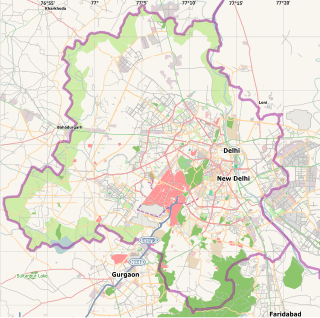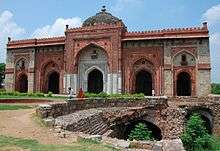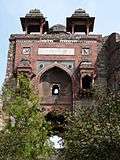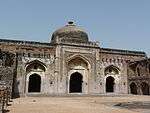Purana Qila
Purana Qila, Hindustani for Old Fort also formerly called Shergarh & Sher Fort is one of the oldest forts in Delhi, India. The site has been continuously inhabited for 2,500 years and remains dating from the pre-Mauryan period have been found. The present citadel was begun in the time of Humayun and its construction continued under Sher Shah Suri. The site is often identified with the site of Indraprastha, the capital of the kingdoms of the Pandavas from the Mahabharata.
| Old Fort | |
|---|---|
 Purana Qila Ramparts and lake | |
| Location | Delhi, India |
| Coordinates | |
| Built | 16th century CE |
| Original use | Fortress |
 Purana Qila in Delhi  Purana Qila (India)  Purana Qila (Asia) .svg.png) Purana Qila (Earth) | |
History
Excavations point to traces from the 3rd century BC, the pre-Mauryan period. The first two rounds of excavations – in 1954–55 and 1969–72 – by BB Lal, then director of the Archaeological Survey of India (ASI), had unearthed traces of Painted Grey Ware culture (PGW) under the mound. At the time, Lal had embarked on a mission to excavate various sites mentioned in the Mahabharata text and had found such traces as a common feature at all those sites.[1] On the basis of traces of the PGW, Lal concluded that it was the site of the Pandava kingdom of Indraprastha, estimating 900 BCE as the period of the Kurukshetra war. Later on, excavation conducted by Dr. Vasant Kumar Swarnkar, Superintending Archaeologist of the Archaeological Survey of India during 2013-14 and 2017-18 confirms that the site of Purana Qila has a continuous habitation from Pre-Maurya era to British era. Swarnkar has stated that they have not found the PGW in a stratified layer which will attest to the presence of its culture.[1] Alexander Cunningham identified the fort with that of Indraprastha, though he referred to the present structure as built by Muslims.[2]
The origins of the Purana Qila lie in the walls of Dinpanah, the new city of Delhi being constructed by Mughal emperor Humayun.[3] Abul Fazl states that he built the fort in the place of that of ancient Indraprastha.[4] The founder of the Suri Dynasty, Sher Shah Suri, defeated Humayun and made changes to the fort, strengthening its fortifications and completing its walls. He also had another fort built there called Shergarh, where the governor resided. His project, however, was a continuation of Humayun's construction of a citadel for a royal city. He also built many structures inside the fort. Additions to the fort have been believed to have been made even after his rule. The extent of his contribution to the fort's construction is disputed. The historical attribution of its construction is also uncertain judging from primary sources. Muhammad Khwandamir said that Humayun laid the foundation of the city on a mound near Yamuna. The construction of the walls and fortifications were almost finished by Humayun's time. Tarikh-i-Da'udi states that Sher Shah Suri's royal city remained incomplete upon his death and he had named his fort Shergarh. Abbas Sarwani states the two forts being constructed by him were incomplete when he died. Tarikh-i-Khan-Jahan states that Salim Shah Suri had constructed a wall defending Dinpanah of Humayun.[5]
Purana Qila and its environs flourished as the "sixth city of Delhi". In the year 1556, on 7th October Hindu king Hem Chandra Vikramaditya was crowned in Purana Quila, who had defeated Akbar's forces decisively at Battle of Delhi (1556). Edwin Lutyens who designed the new capital of British India, New Delhi, in the 1920s, had aligned the central vista, now Rajpath, with Purana Qila.[6] During the Partition of India, in August 1947 the Purana Qila along with the neighbouring Humayun's Tomb, became the site for refuge camps for Muslims migrating to newly founded Pakistan. This included over 12,000 government employees who had opted for service in Pakistan, and between 150,000–200,000 Muslim refugees,[7] who swarmed inside Purana Qila by September 1947, when Indian government took over the management of the two camps. The Purana Qila camp remained functional until early 1948, as the trains to Pakistan waited until October 1947 to start.[8]
In the 1970s, the ramparts of Purana Qila were first used as a backdrop for theatre, when three productions of the National School of Drama were staged here: Tughlaq, Andha Yug and Sultan Razia, directed by Ebrahim Alkazi. In later decades it has been the venue of various important theatre productions, cultural events, and concerts.[9] Today, it is the venue of a daily sound and light presentation after sunset, on the history of the "Seven Cities of Delhi", from Indraprastha through New Delhi.[10]
Indraprastha
Delhi is thought by some to be located at the site of the legendary city of Indraprastha founded by the Pandavas from Mahabharata period, which is consequently considered the 'First City of Delhi'.[11] Until 1913, a village called Indrapat existed within the fort walls.[12]
Timings
The normal visiting hours are from 7:00 A.M. to 5:00 pm.[13]
Excavations
Archaeological Survey of India (ASI) carried out excavations at Purana Qila in 1954–55 and again from 1969 to 1973 by B. B. Lal, and in 2013-14 & 2017-18 by Vasant Kumar Swarnkar. its findings and artefacts are exhibited at the Archaeological Museum, Purana Qila. This includes Painted Grey Ware, dating 1000 BC, and various objects and pottery signifying continuous habitation from Mauryan to Shunga, Kushana, Gupta, Rajput, Delhi Sultanate and Mughal periods.[14][15] The homes built during the Rajput era were built of bricks used in other structures and also mud bricks. A fortification wall about 30 metre long was also found. During the Delhi Suntanate, structures were made from re-used bricks and over the ruins of earlier structures. The Mughal era structures were characterized by a deep pit dug over those of the preceding eras.[16]
Construction
The walls of the Fort rise to a height of 18 metres, traverse about 1.5 km, and have three arched gateways: the Bara Darwaza (Big Gate) facing west, which is still in use today; the south gate, also popularly known as the 'Humayun Gate' (probably so known because it was constructed by Humayun, or perhaps because Humayun's Tomb is visible from there); and lastly, the 'Talaqi Gate', often known as the "forbidden gate". All the gates are double-storeyed sandstone structures flanked by two huge semi-circular bastion towers, decorated with white and coloured-marble inlays and blue tiles. They are replete with detailing, including ornate overhanging balconies, or jharokhas, and are topped by pillared pavilions (chhatris), all features that are reminiscent of Rajasthani architecture as seen in the North and South Gates, and which were amply repeated in future Mughal architecture. Despite the grandeurs of the exterior, few of interior structures have survived except the Qila-i Kuhna Mosque and the Shermandal, both credited to Sher Shah.[17]
Qila-i-Kuhna Mosque

The single-domed Qila-i-Kuna Mosque, built by Sher Shah in 1541 is an excellent example of a pre-Mughal design, and an early example of the extensive use of the pointed arch in the region as seen in its five doorways with the 'true' horseshoe-shaped arches. It was designed as a Jami Mosque, or Friday mosque for the Sultan and his courtiers. The prayer hall inside, the single-aisled mosque, measures 51.20m by 14.90m and has five elegant arched prayer niches or mihrabs set in its western wall. Marble in shades of red, white and slate is used for the calligraphic inscriptions on the central iwan, marks a transition from Lodhi to Mughal architecture. At one time, the courtyard had a shallow tank, with a fountain.
A second storey, accessed through staircases from the prayer hall, with a narrow passage running along the rectangular hall, provided space for female courtiers to pray, while the arched doorway on the left wall, framed by ornate jharokas, was reserved for members of the royal family.[18] On a marble slab within the mosque an inscription reads: "As long as there are people on the earth, may this edifice be frequented and people be happy and cheerful in it".[12] Today it is the best preserved building in Purana Qila.[19][20]
Sher Mandal

The Sher Mandal named for Farid (Sher Shah) who had tried to finish what was ordered by Babur but had died during the initial phase and so construction was halted until the arrival of Humayun.
This double-storeyed octagonal tower of red sandstone with steep stairs leading up to the roof was intended to be higher than its existing height. Its original builder was Babur who ordered the construction and was used as a personal observatory and library for his son Humayun, finished only after he recaptured the fort. It is also one of the first observatories of Delhi, the earliest being in Pir Ghaib at Hindu Rao at Ridge built in the 14th century by Firoz Shah Tughlaq. The tower is topped by an octagonal chhatri supported by eight pillars and decorated with white marble in typical Mughal style.
Inside, there are remnants of the decorative plaster-work and traces of stone-shelving where, presumably, the emperor's books were placed.
This was also the spot where, on 24 January 1556 Humayun fell from the second floor to his death. He slipped while hastening to the evening prayers, following his hobby of astronomical star gazing at the top of this private observatory. He fell headlong down the stairs and died of his injuries two days later. Entry inside the library is now prohibited.
Outlying monuments
Several other monuments lie around the complex, like Kairul Manzil, mosque built by Maham Anga, Akbar's foster-mother, and which was later used as a madarsa. Sher Shah Suri Gate or Lal Darwaza, which was the southern gate to Shergarh, also lies opposite the Purana Qila complex, across Mathura Road, south-east of the Kairul Manzil.
Gallery
 Humayun Gate
Humayun Gate West Gate, 'Bara Darwaza', present main Entrance, with its bastion
West Gate, 'Bara Darwaza', present main Entrance, with its bastion Lake outside Purana Qila
Lake outside Purana Qila- Remains of large outer walls
 Qila-i-Kuhna Mosque 'Peshtak' (Entrance Arch)
Qila-i-Kuhna Mosque 'Peshtak' (Entrance Arch) North Gate, or Talaqi Darwaza
North Gate, or Talaqi Darwaza North Gate interior
North Gate interior South Gate, as seen from adjacent Delhi Zoo
South Gate, as seen from adjacent Delhi Zoo Khairul Manzil, a mosque and later a madarsa built by Maham Anga, stands opposite Purana Qila.
Khairul Manzil, a mosque and later a madarsa built by Maham Anga, stands opposite Purana Qila. Hammam Khana (Bath House) in Purana Qila
Hammam Khana (Bath House) in Purana Qila
Further reading
- The Seven Cities of Delhi, by Hearn, Gordon Risley. 2005. ISBN 81-7305-300-6.
- Invisible City—The Hidden Monuments of Delhi, by Rakhshanda Jalil, photographs by Prabhas Roy, Niyogi Books. 2008. ISBN 81-89738-14-3.
References
- "New find in Purana Qila pushes Delhi history back by centuries". 27 January 2018.
- Rajagopalan, Mrinali. Building Histories: The Archival and Affective Lives of Five Monuments in Modern Delhi. p. 129.
- Muqarnas: An Annual on Islamic Art and Architecture, by Oleg Grabar. Published by BRILL, 1987. ISBN 90-04-08155-0. Page 133.
- Singh, Upinder. A History of Ancient and Early Medieval India: From the Stone Age to the 12th Century. p. 20.
- D'Ayala, Diana. Structural Analysis of Historic Construction: Preserving Safety and Significance. pp. 289, 290, 291.
- Polk, Emily (1963). Delhi, old & new. Rand McNally. p. 76.
- Kamra, Sukeshi (2002). Bearing Witness: Partition, Independence, End of the Raj. University of Calgary Press. p. 174. ISBN 1-55238-041-6.
- Zamindar, Vazira Fazila-Yacoobali (2007). The long partition and the making of modern South Asia: refugees, boundaries, histories. Columbia University Press. p. 34. ISBN 0-231-13846-6.
- "A little peek into history". The Hindu. 2 May 2008.
- "Sound and Light Show at Purana Quila in New Delhi India". www.india9.com.
- Delhi City The Imperial Gazetteer of India, 1909, v. 11, p. 236..
- Delhi city guide, by Eicher Goodearth Limited, Delhi Tourism. Published by Eicher Goodearth Limited, 1998. ISBN 81-900601-2-0. Page 162
- "Purana Qila / Old Fort, Delhi , Delhi". 22 September 2018.
- Archaeological Museum, Purana Qila (New Delhi) Archaeological Survey of India website.
- Singh, Upinder (2006). Delhi: Ancient History. Berghahn Books. p. 53. ISBN 81-87358-29-7. Retrieved 11 August 2009.
- Singh, Upinder (2006). Delhi: Ancient History. Berghahn Books. p. 55. ISBN 81-87358-29-7. Retrieved 6 June 2019.
- Petersen, Andrew (1996). Dictionary of Islamic architecture. Routledge. p. 201. ISBN 0-415-06084-2. Retrieved 11 August 2009.
- Qila-i Kuhna Mosque Archived 23 November 2014 at Wikiwix archnet.org.
- Islamic architecture of the Indian Subcontinent, by Bianca Maria Alfieri. Laurence King Pub., 2000. ISBN 3-8238-5443-7. Page 193.
- "Delhi's Belly: Unknown city, Glimpses of Delhi's past through monuments that dot almost every neighbourhood". Live Mint. 1 April 2011.
External links
![]()